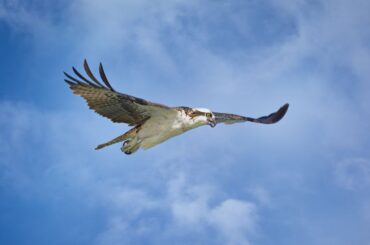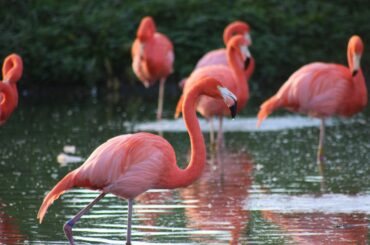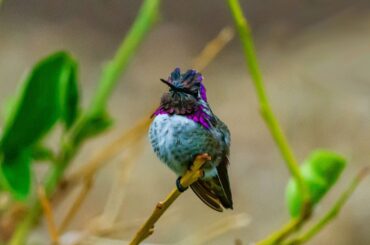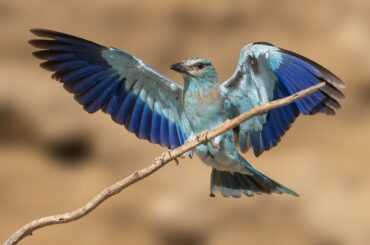Have you taken the time to ponder why Florida is home to so many eagles? This article will investigate the behaviors and characteristics that make them such remarkable sights in our state.
Beyond the beautiful beaches, temperate climate, and unique habitats Florida is known for, it is also renowned as an avian paradise. From migratory birds to resident species, this Sunshine State offers refuge to many feathered friends.
Florida’s Eagles have impressive talons for hunting and powerful beaks to break apart flesh and feast on fruits or vegetation. These Eagles can generally be seen in high perches, in tall trees or cliffs, that offer an optimal view of their surroundings while protecting their nests from threats, such as raccoons, owls, and hawks.
When planning a trip to Florida, allow yourself to witness these incredible animals living in their natural habitat. For any nature lover, nothing compares to watching various eagles showcasing their physical features and behaviors.
1. Bald Eagle
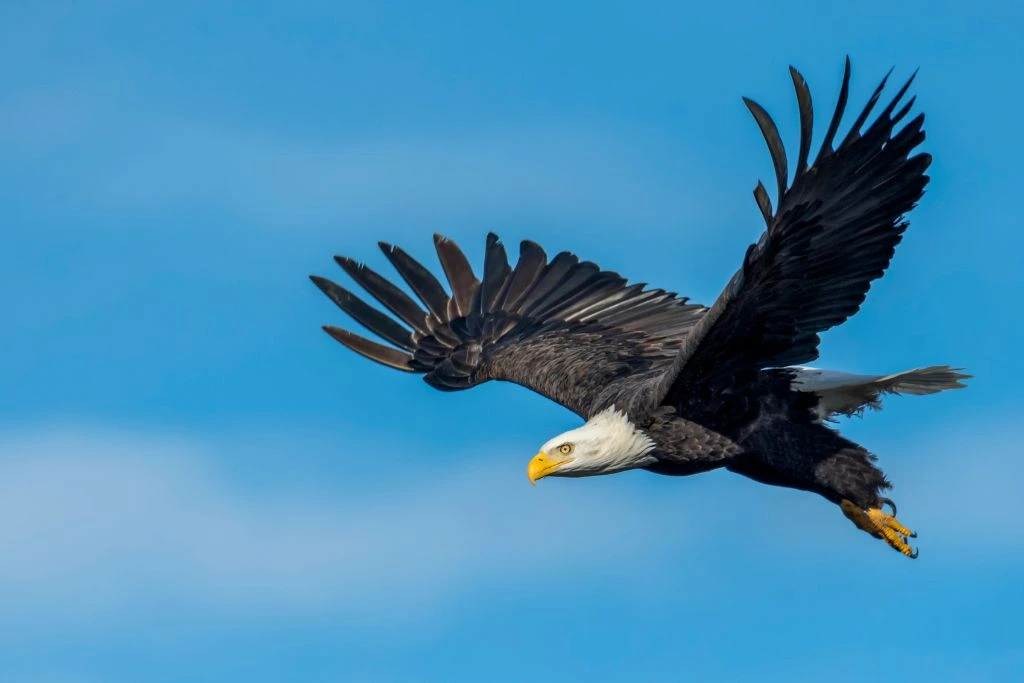
- Kingdom: Animalia
- Phylum: Chordata
- Class: Aves
- Order: Accipitriformes
- Genus: Haliaeetus
- Species: Haliaeetus leucocephalus
The Bald Eagle (Haliaeetus leucocephalus) is an awe-inspiring bird, admired for its grandeur and might. Its size alone speaks to these characteristics, reaching a massive wingspan of 6 to 7.5 feet, combined with a body length of 28 to 40 inches, making it one of the most gigantic birds in North America!
In Florida, the baby eagles rely on their family for sustenance, primarily consuming fish found in nearby water sources. As time passes and they grow, these young birds gain the skills needed to hunt independently and sharpen their chances of survival. They typically choose to build their nesting site on tall trees close to a water source.
Numerous eagles can be spotted from the northern to southern regions of Florida; however, the Kissimmee Chain of Lakes area and the St. Johns River watersheds are home to an especially high concentration of these majestic birds.
Bald Eagles in Florida are highly opportunistic hunters that take advantage of a range of potential prey. In addition to fish, their diet includes small mammals, like rabbits and squirrels, as well as reptiles, such as snakes and turtles.
The keen vision of Bald Eagles is enhanced by their capability to adjust their focus rapidly, which comes in handy when they dive sharply to catch prey. These majestic birds can change the shape of their lens up to ten times faster than humans, allowing them to pinpoint accuracy while locking on a target.
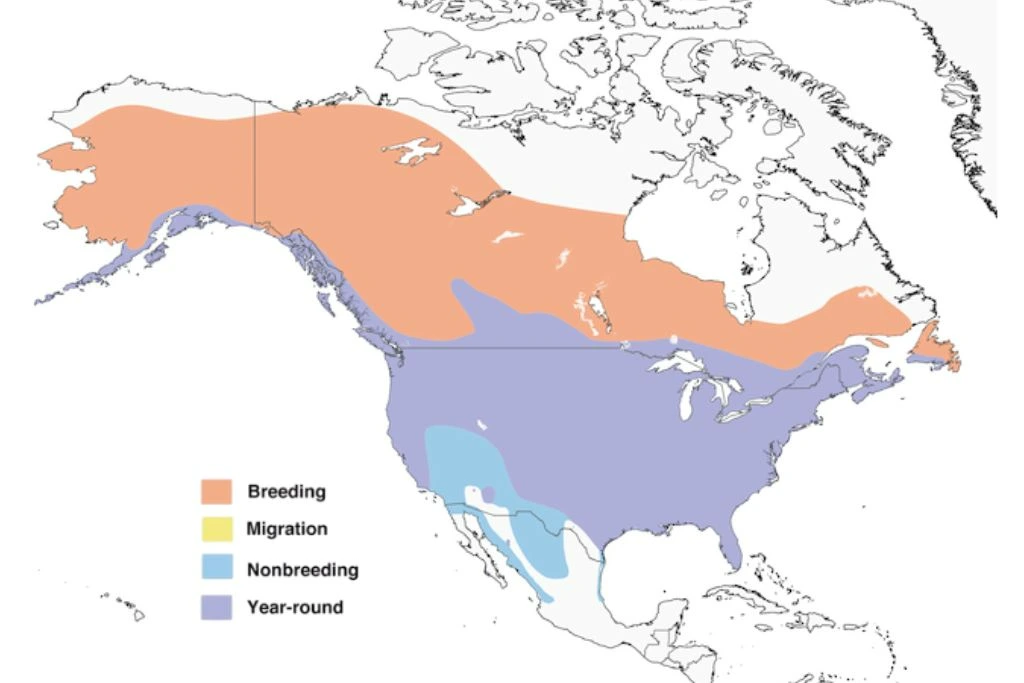
2. Golden Eagle

- Kingdom: Animalia
- Phylum: Chordata
- Class: Aves
- Order: Accipitriformes
- Genus: Aquila
- Species: Aquila chrysaetos
Are there Golden Eagles (Aquila Chrysaetos) in Florida? Yes! Aquila chrysaetos, commonly known as golden eagles, can be spotted in many areas across North America, Europe, Asia, and Northern Africa.
When it comes to size, they can reach 6 to 7.5 feet and weigh up to 12 pounds, with females generally more prominent than males. These raptors boast a unique plumage of dark brown with golden feathers decorating the backside of their neck and head, earning them the fitting name of “Golden-Capped.”
The Golden Eagle symbolizes determination and bravery, evident through its presence on flags, coins, and emblems throughout time. These majestic birds can reach incredible speeds (up to 200 miles per hour!) when diving for their prey, making them some of the fastest creatures in existence.
Nature’s resilience is fully displayed in the creatures that inhabit cold climates, from tundras and grasslands to high mountains and cliffsides. Many are found at altitudes of up to 12,000 feet – a remarkable feat given how extreme these temperatures can be. These animals genuinely demonstrate nature’s capacity for survival!
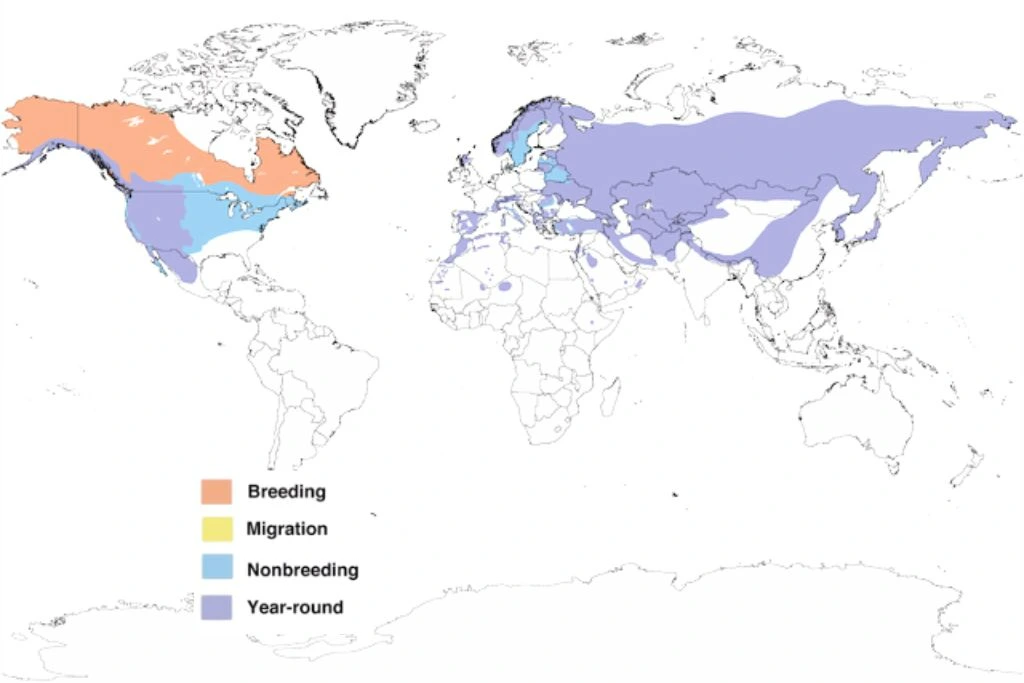
3. Northern Harrier

- Kingdom: Animalia
- Phylum: Chordata
- Class: Aves
- Order: Accipitriformes
- Genus: Circus
- Species: Circus hudsonius
The scientific name, Circus Hudsonius, comes from Latin and means “circle” (circus) and refers to its circular flight pattern. At the same time, Hudsonius denotes its connection to Henry Hudson, an explorer in the Americas.
With an impressive owl-like facial disk, this bird is truly one of a kind. It not only gives it an unforgettable visage but also aids in its exceptional hunting abilities by amplifying and redirecting sound waves toward the ears for heightened hearing capabilities.
As the baby eagles hatch in Florida, they exhibit fascinating characteristics. Covered with a soft down, these adorable little creatures rely entirely on their parents for food and protection. The female remains close to the nest to care for her young hatchlings, whereas the male provides food for both the female and the offspring.
The young Northern Harrier Eagles fledge or start flying when they are approximately 30 to 35 days old. As they explore their surroundings and develop their hunting skills, they break away from relying on their parents’ provisions.
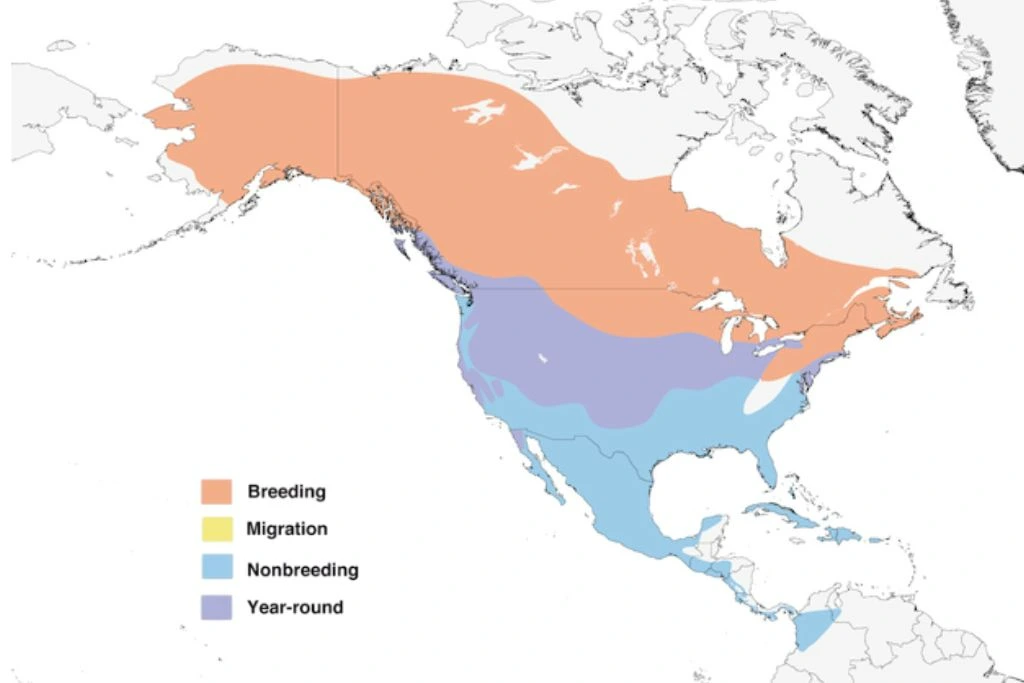
4. Osprey

- Kingdom: Animalia
- Phylum: Chordata
- Class: Aves
- Order: Accipitriformes
- Genus: Pandionidae
- Species: Pandionidae haliaetus
Ospreys (Pandion haliaetus) are remarkable birds of prey known for their impressive fishing skills. They boast a wingspan of 150 to 180 centimeters (59 to 71 inches) and a body length of 50 to 66 centimeters (20 to 26 inches).
These powerful raptors are easily identifiable thanks to their dark brown dorsal feathers, contrasting white underparts, and prominent black stripes running through their piercing yellow eyes.
The Osprey is a year-round inhabitant of Florida, where it both breeds and serves as a migratory stopover for those traveling between more northern areas and Central/South America. It is widely distributed in North America and is known for its highly migratory behavior at higher latitudes.
Ospreys boast impressive wingspans and muscular legs, enabling them to swoop down awe-inspiringly as they catch their prey from the water. These raptors have closable nostrils that protect against water infiltration when diving at depths of up to three feet!

5. Red-Shouldered Hawk
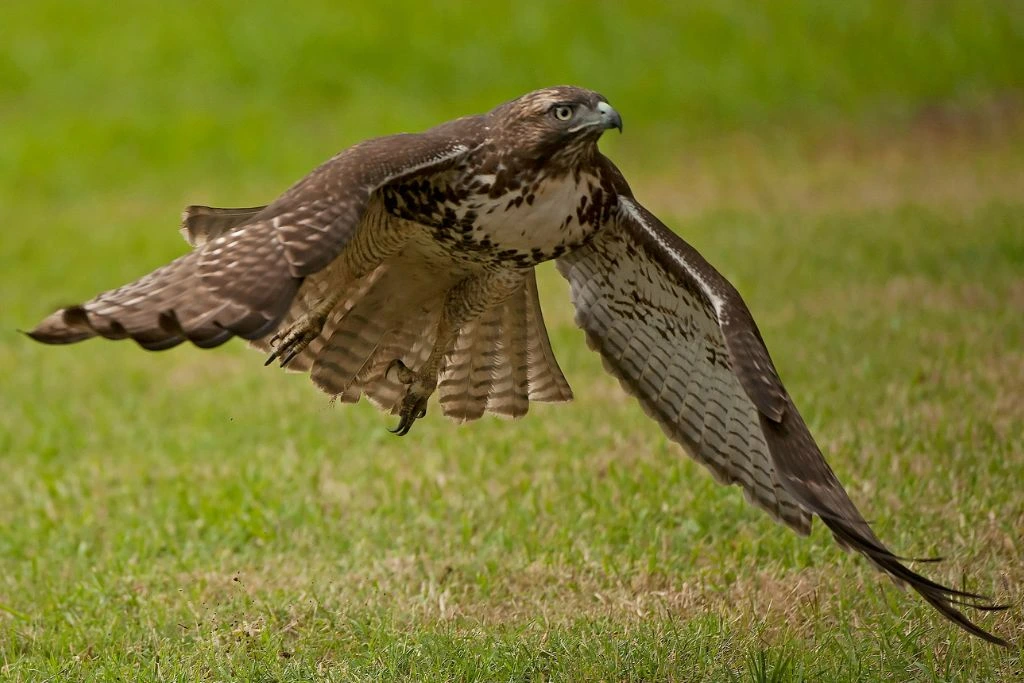
- Kingdom: Animalia
- Phylum: Chordata
- Class: Aves
- Order: Accipitriformes
- Genus: Buteo
- Species: Buteo lineatus
Red-Shouldered Hawks (Buteo Lineatus) are found primarily in woodlands and forests in Eastern and Central North America, as well as parts of California and the Baja Peninsula. They have developed various adaptations that help them thrive in these environments.
This bird is recognized for its remarkable feathers that showcase dark reddish-brown shoulders, deep brown upper parts, and a distinctive checkered design on the front wings. Its underbelly has a light buff hue with a unique reddish-brown streak pattern on the chest and abdomen.
They have bands of black and white-tailed eagles. The bird’s vibrant yellow feet and legs are further highlighted by its piercing golden eyes. On average, adult males generally measure between 35 to 50 inches in wingspan and weigh 17.3 to 24.7 ounces; females tend to be slightly larger than their male counterparts.
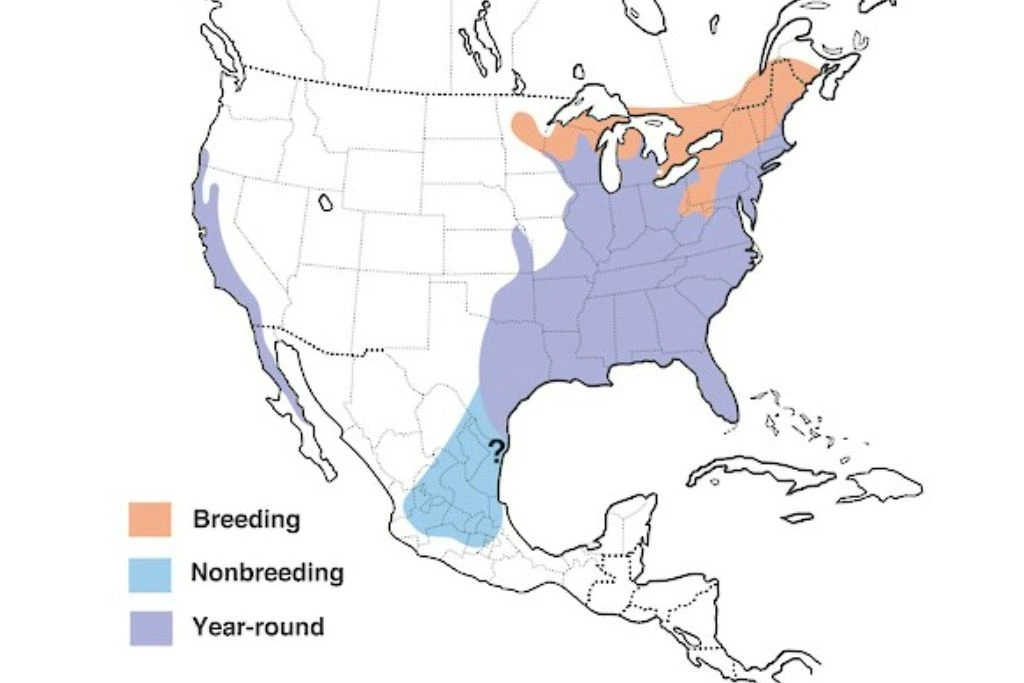
6. Red-Tailed Hawk
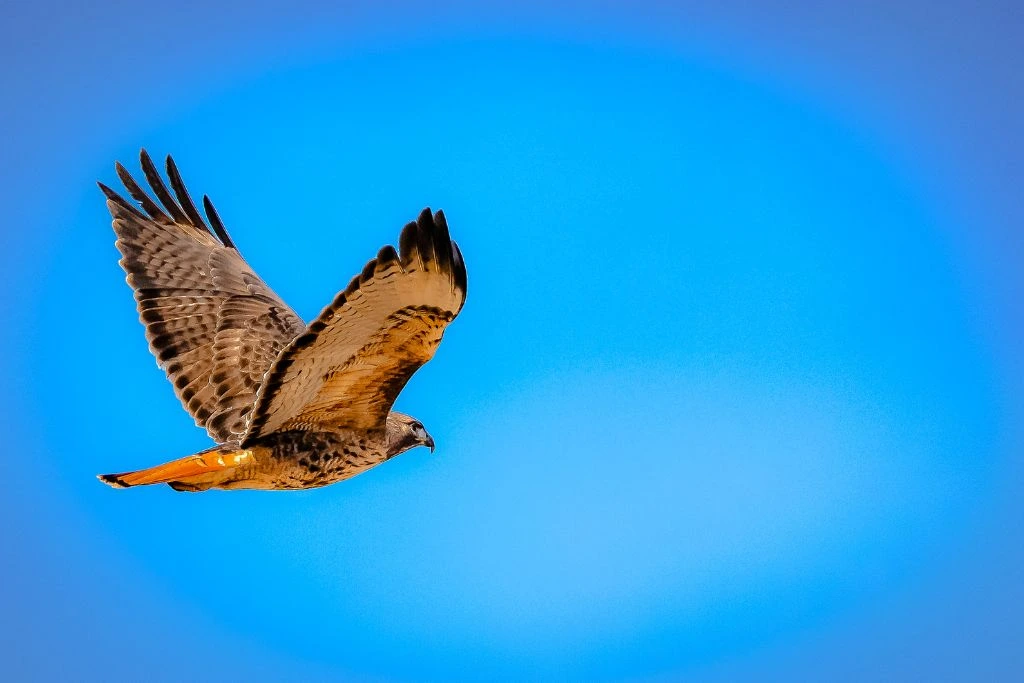
- Kingdom: Animalia
- Phylum: Chordata
- Class: Aves
- Order: Accipitriformes
- Genus: Buteo
- Species: Buteo jamaicensis
The Red-tailed Hawk (Buteo Jamaicensis) is renowned for its characteristic raspy cry, which can be heard in films and T.V. shows as a general noise effect for eagles or other raptors. As if that wasn’t impressive enough, the longest-living documented wild Red-tailed Hawk lived to an astonishing 30 years – more than double the average life span of 10 to 15 years!
Adult Red-Tails boast a rich brown color on their upper body and a lighter shade on the underparts. Besides their trademark reddish-brown tail, they also exhibit a distinctive dark band spanning their broad wings.
These raptors exhibit exceptional flying and hunting skills. They utilize thermal updrafts for soaring at high altitudes while keeping a watchful eye on potential prey. Their incredible vision – around eight times more powerful than humans – allows them to spot their game from great distances.
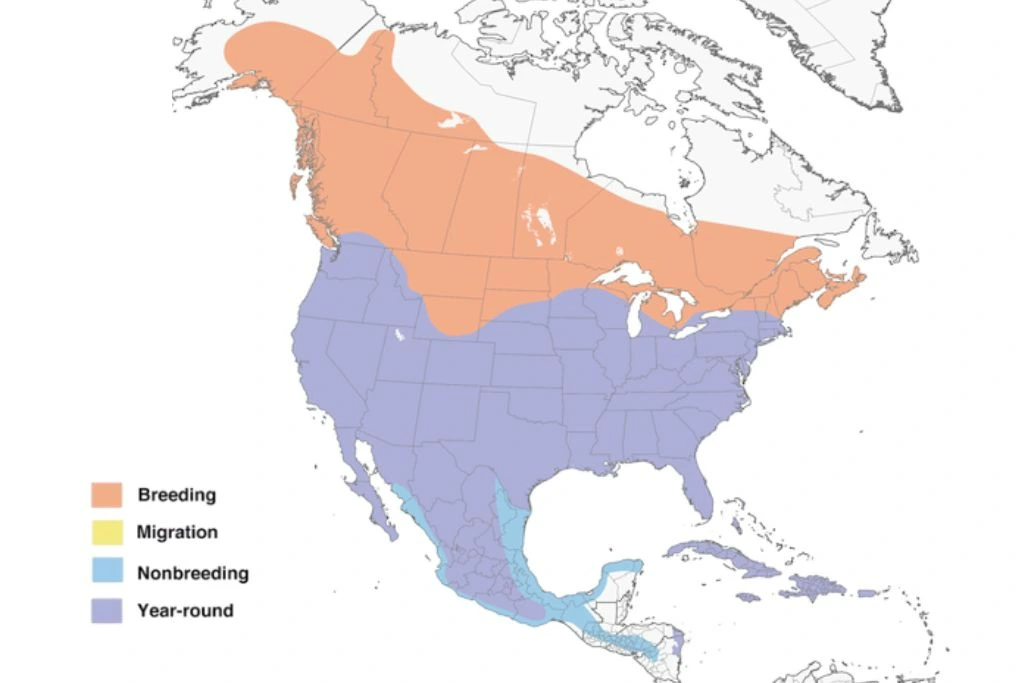
7. Swallow-Tailed Kite
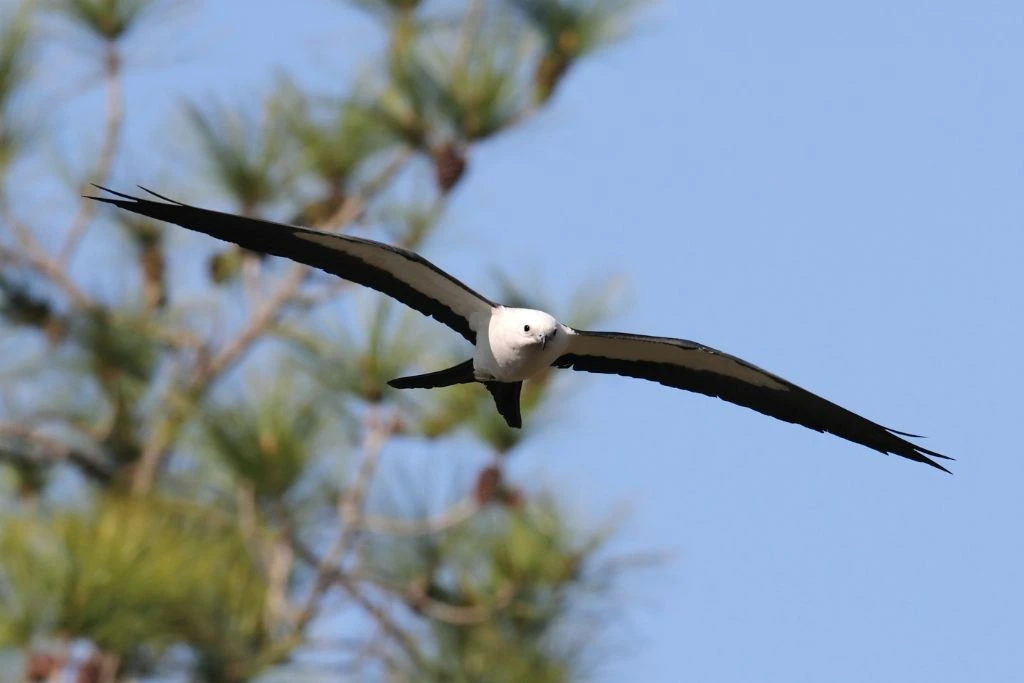
- Kingdom: Animalia
- Phylum: Chordata
- Class: Aves
- Order: Accipitriformes
- Genus: Elanoides
- Species: Elanoides forficatus
Swallow-Tailed Kites (Elanoides Forficatus) possess an agile in-flight feeding approach that makes it unnecessary for them to land frequently. They typically skim above the surface of lakes, rivers, or ponds with their beaks open wide enough to take up water while still soaring through the air.
The breathtaking Swallow-Tailed Kite (Elanoides forficatus) is an elegant bird of prey, easily identified by its signature, deeply forked tail. This medium-sized raptor stands out among other species in beauty and radiance with a glossy black or dark blue coloring on the head, back, and seat, paired with bright white underparts and throat.
These majestic creatures have a wide distribution, ranging from the Southeastern United States to Northern Argentina. Every year, these birds migrate northward toward the U.S., primarily Florida, and other nearby states, during the breeding season (spring to summer). But as winter approaches, they go south in search of warmer climates.
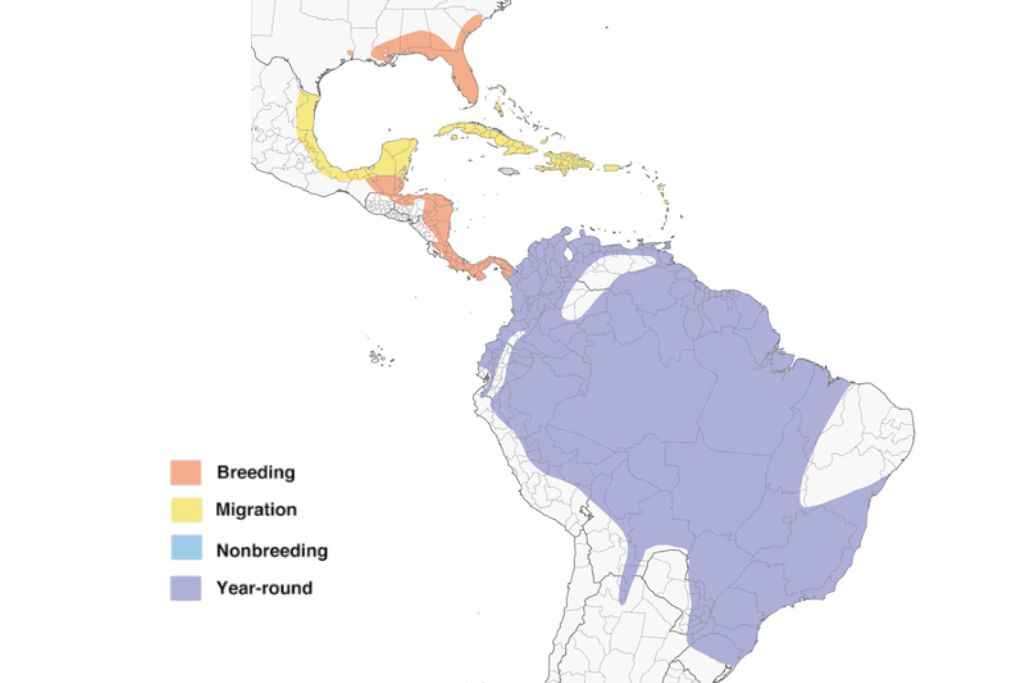
8. White-Tailed Kite
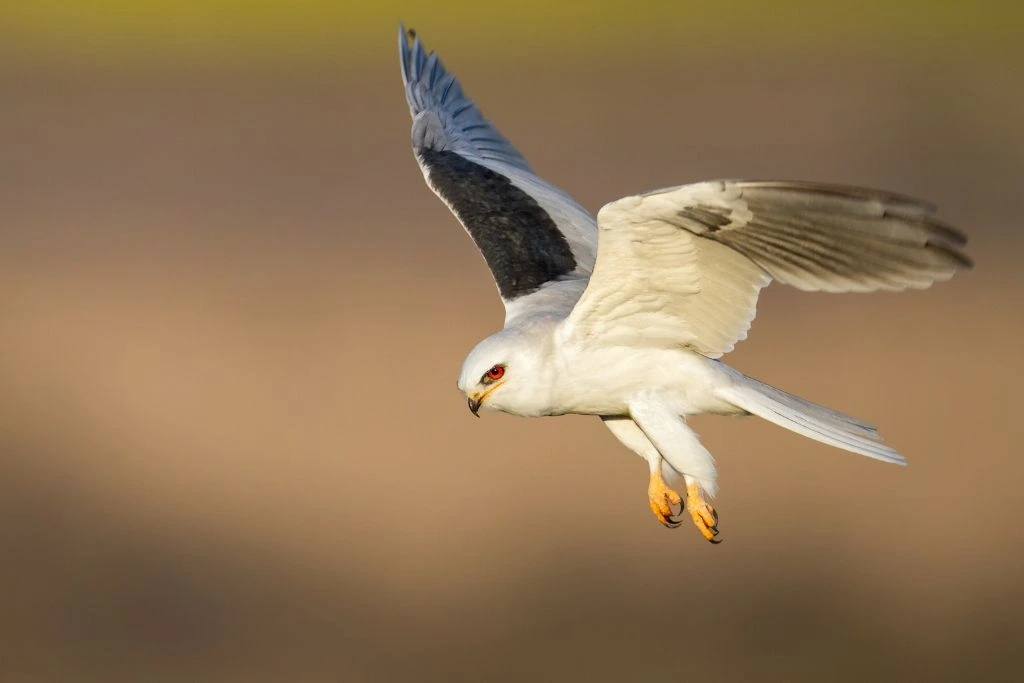
- Kingdom: Animalia
- Phylum: Chordata
- Class: Aves
- Order: Accipitriformes
- Genus: Elanus
- Species: Elanus Leucurus
White-Tailed Kites (Elanus Leucurus) are renowned for their elegant, airy flight and the aerial hunting technique known as “kiting,” which involves hovering in place before descending to catch their prey.
Capable of living in diverse settings, these impressive birds can be found inhabiting grasslands, savannas, marshes, meadows, and early successional forests. They enjoy being near areas with abundant vegetation and close to water sources as they feast on small mammals.
White-Tailed Kites are known for their unique, high-pitched, whistling communication calls. These are often used to maintain contact between mates or family members and may be given as alarm calls or territorial songs.
The rapid decline of these birds in North America due to massive habitat destruction and hunting during the early 1900s nearly caused their extinction. Fortunately, thanks to conservation efforts, these avian creatures have bounced back from near-extinction and are now classified by IUCN as a species of the least concern.
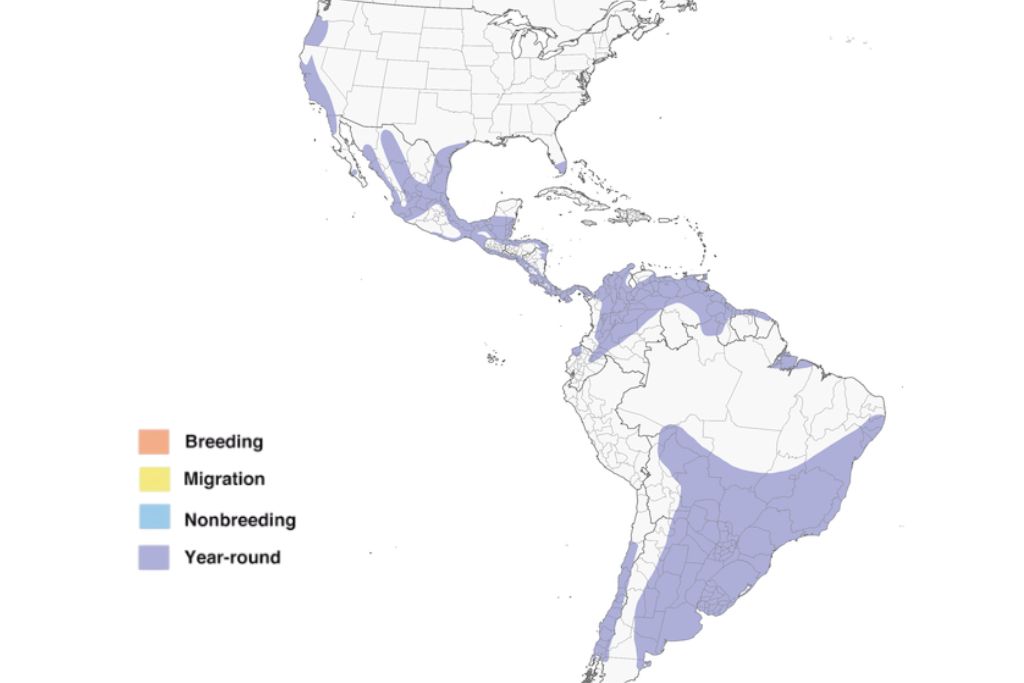
9. Short-Tailed Hawk

- Kingdom: Animalia
- Phylum: Chordata
- Class: Aves
- Order: Accipitriformes
- Genus: Buteo
- Species: Buteo Brachyurus
Adult Short-Tailed Hawks (Buteo Brachyurus) come in two striking color variations: a dark morph, featuring an ebony upper body/underparts, and a light morph, with its stark white belly contrasting the darker hues of its head, back, and wings.
Depending on their geographical location, Short-Tailed Hawks have their nesting season ranging from March to July in the U.S. and September to December in South America. Despite this broad distribution, sightings of these raptors remain rare, making them a desirable sighting for birdwatchers worldwide.
Short-Tailed Hawks are exceptionally well-adapted to their environment, capable of soaring high above the canopy and gliding without flapping their wings. This allows them to effortlessly spot their prey, mainly consisting of small birds and occasionally small mammals, reptiles, and insects.
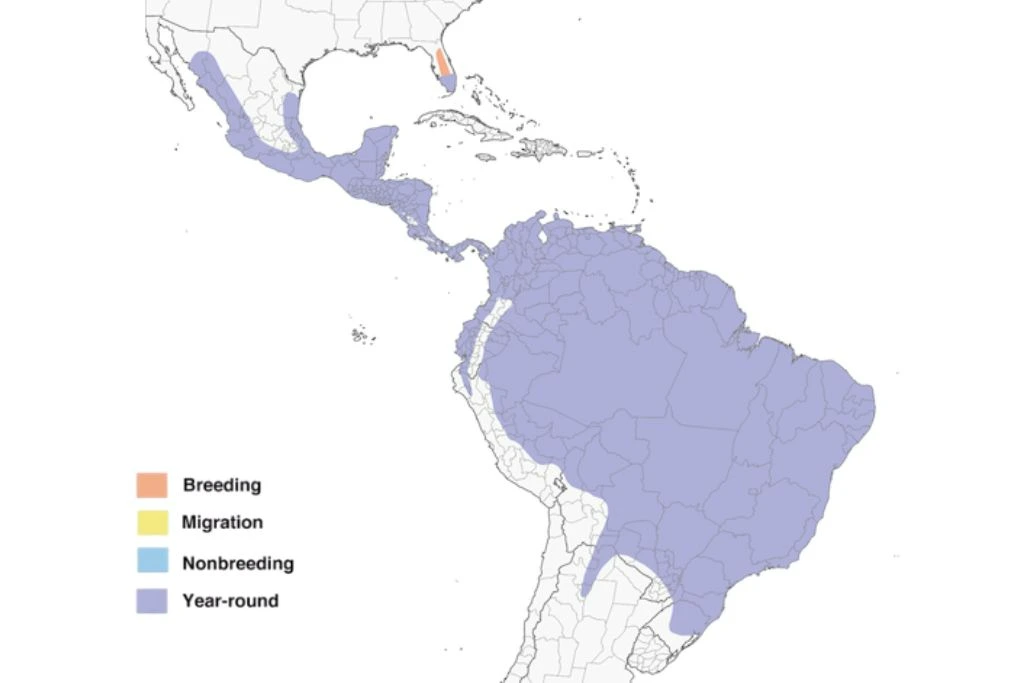
10. Rough-Legged Hawk
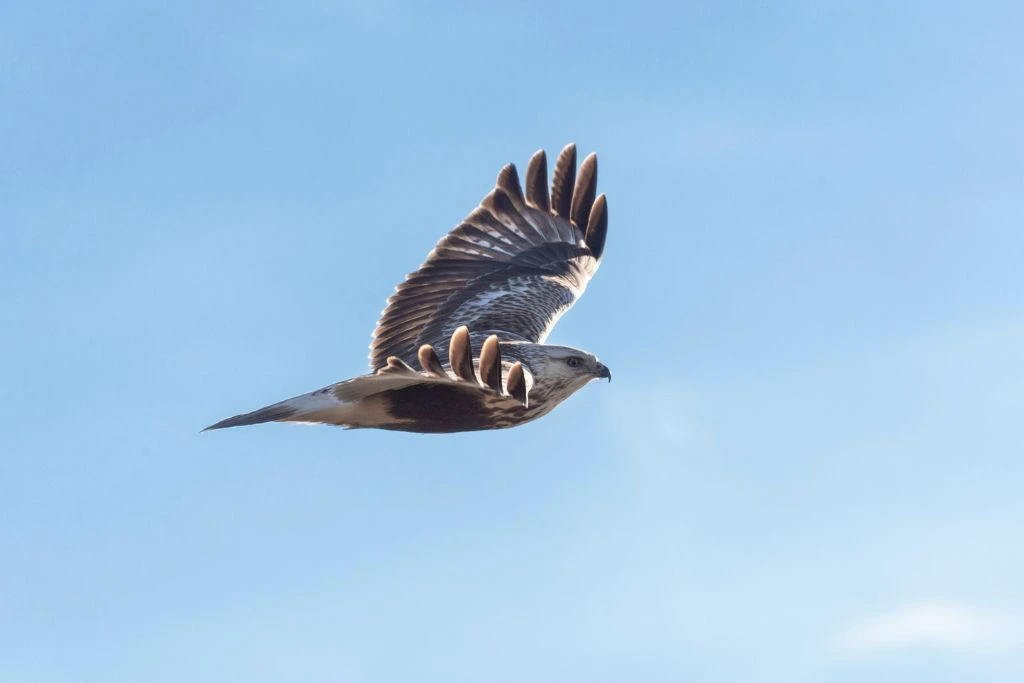
- Kingdom: Animalia
- Phylum: Chordata
- Class: Aves
- Order: Accipitriformes
- Genus: Buteo
- Species: Buteo Lagopus
The Rough-Legged Hawk (Buteo lagopus) stands out among birds of prey with its distinct plumage, feathers on the legs, and exceptional soaring capabilities. This medium to large-sized raptor has a brownish upper body while its underside is adorned in white or cream hues marked by dark streaks or spots.
Compared to other raptors, Rough-Legged Hawks reproduce late and form monogamous couples. During this time, the males and the females aggressively protect their nests.
In areas of treeless tundra, these eagles favor building their nests on cliffs, rocky outcrops, or even man-made structures. They may even use other birds’ abandoned nests on rare occasions or develop their own on the ground.
Rough-Legged Hawks are considered relatively docile and forgiving of people despite being fearsome and agile predators, occasionally even allowing for close observation in the wild.
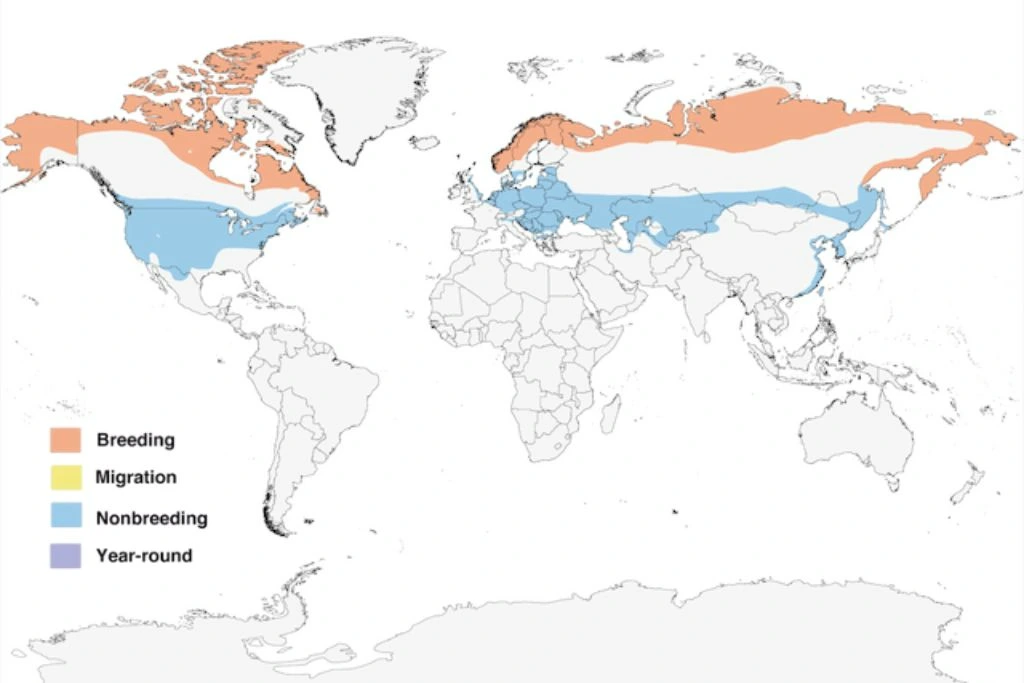
Conclusion
Eagles in Florida exhibit an impressive range of varieties, each uniquely showcasing features that make them magnificent creations. Their habitat preference, specialized diets, and hunting abilities make them captivating creatures to observe.
We must appreciate and value their beauty so that future generations can enjoy their magnificence. It’s our responsibility to protect their habitats and ensure their survival. Let’s show them the utmost respect they deserve!
FAQs
What do Eagles look like in Florida?
Eagles in Florida vary depending on the species, but they typically have large, broad wings and a hooked beak. Their plumage can range from white to black with brown, gray, and tan accents. Some species may have unique facial markings like crests or orange patches near their beak.
How rare is it to see an Eagle in Florida?
It is common to see an eagle in Florida, as the state has many large raptors visible throughout the year. However, some species may be more difficult to spot than others due to their habitat preference or elusive nature.
How big are Florida Eagles?
Florida eagles vary in size depending on the species. The smallest, the American Kestrel, has a wingspan of up to 20 inches and can weigh up to 7 ounces. The largest, the Bald Eagle, has a wingspan of up to 79 inches and can weigh up to 14 pounds.
Where can I see Eagles in Florida?
Eagles can be seen throughout various habitats in Florida, from open country and savannahs to grasslands and tropical rainforests. They are most commonly found near bodies of water, such as rivers, lakes, and coasts. It is also possible to observe eagles at bird sanctuaries or wildlife refuges.


